Nacella macquariensis is a species of true limpet, a marine gastropod mollusc in the family Nacellidae. It is found on the lower foreshore and in the shallow sub-littoral zone of certain islands in the southern Indian Ocean and Southern Ocean.

Patellidae is a taxonomic family of true limpets, marine gastropod molluscs in the superfamily Patelloidea. (The superfamily Patelloidea should not be confused with the similar-sounding genus of true limpets Patelloida which is in the family Lottiidae within the superfamily Lottioidea, also part of the Patellogastropoda.)

Cellana is a genus of sea snails or limpets, marine gastropod molluscs in the family Nacellidae, the true limpets.

Mollusca is the second-largest phylum of invertebrate animals, after Arthropoda; members are known as molluscs or mollusks. Around 76,000 extant species of molluscs are recognized. The number of fossil species is estimated between 60,000 and 100,000 additional species. The proportion of undescribed species is very high. Many taxa remain poorly studied.

Patella is a genus of sea snails with gills, typical true limpets, marine gastropod mollusks in the family Patellidae, the true limpets.

Cymbula adansonii is a species of sea snail, a true limpet, a marine gastropod mollusk in the family Patellidae. It is one of the several families of true limpets. Marine gastropods, colloquially classified as snails and slugs, encompass the entire class of invertebrates in the Mollusca phylum. True limpets, are pelagic snails within the Patellidae family.
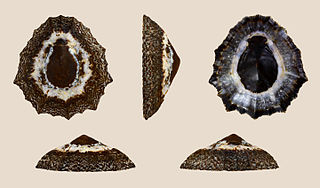
Cymbula granatina, the granite limpet, is a species of sea snail, a true limpet, a marine gastropod mollusc in the family Patellidae, one of the families of true limpets. Unlike some other species of giant limpet, C. granatina is non-territorial, and feeds on a variety of different algae.

Cymbula oculus is a species of sea snail, a true limpet, a marine gastropod mollusk in the family Patellidae, one of the families of true limpets.

Patella ferruginea, commonly known as the ferruginous limpet is a species of true limpet, a marine gastropod mollusk in the family Patellidae. It is a large limpet, endemic to the western Mediterranean Sea, and although common in the past, it is now rare and restricted to only a few locations.
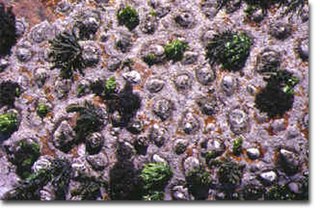
Scutellastra cochlear is a species of sea snail, a marine gastropod mollusc in the family Patellidae, one of the families of true limpets. It is commonly known as the snail patella, the pear limpet or the spoon limpet and is native to South Africa. It often grows in association with the crustose coralline alga Spongites yendoi and a filamentous red alga which it cultivates in a garden. It was first described by the malacologist Ignaz von Born in 1778 as Patella cochlear.

Scutellastra exusta is a species of sea snail, a true limpet, a marine gastropod mollusk in the family Patellidae, one of the families of true limpets. Dead Scutellastra exusta help to form shallow marine sediment beds.
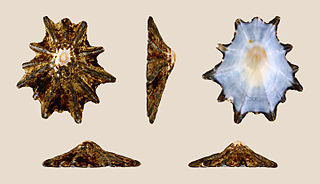
Scutellastra longicosta, the long-spined limpet or the duck's foot limpet, is a species of true limpet, a marine gastropod mollusk in the family Patellidae, one of the families of true limpets. It is native to the coasts of South Africa where it is found on the foreshore. It cultivates a species of crustose brown algae in a "garden".

Cymbula is a genus of sea snails, the true limpets, marine gastropod mollusks in the family Patellidae.

Sicyases sanguineus is a species of amphibious marine clingfish in the family Gobiesocidae. It lives in the Southeast Pacific along the entire coast of Chile and southern Peru.
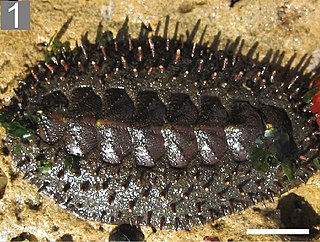
Enoplochiton echinatus is a Southeast Pacific species of edible chiton, a marine polyplacophoran mollusc in the family Chitonidae, the typical chitons.
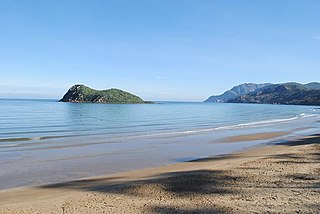
Cala Iris Islet is a small island in Morocco, located in the Alboran Sea in the bay of the Cala Iris village, Al Hoceima Province. It is about 500 m off the Cala Iris beach. This island is a part of the Al Hoceima National Park. Cala Iris Islet is one of the few places where the ribbed Mediterranean limpet has survived, with a population of 110 specimens.
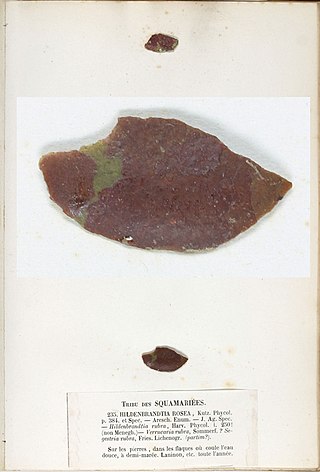
Hildenbrandia rubra is a marine species of thalloid red alga. It forms thin reddish crusts on rocks and pebbles in the intertidal zone and the shallow subtidal zone. It is a common species with a cosmopolitan distribution, and is able to tolerate a wide range of conditions.














